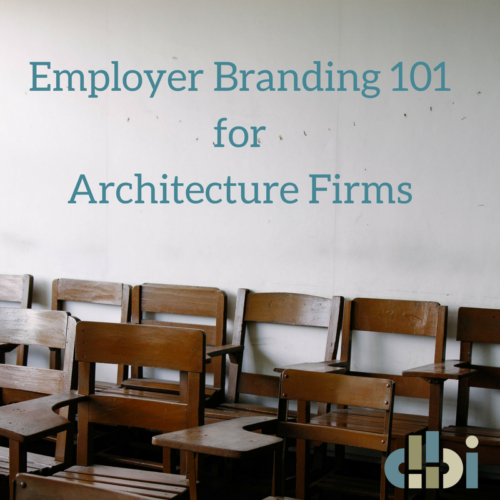
Over the past few weeks I have been sharing the importance of an EVP, Employee Value Proposition. Now that you have an understanding of the EVP I want to talk about its role in your firm’s overall Employer Branding.
First, what is an Employer Brand? In simple terms, it is the information used for potential talent to create their perception of your firm without any connections with your firm. There is a perception of your firm in the market, that’s a fact. An Employer Brand lets your firm take greater control of that message. It is helpful in many areas, business development, marketing, and specific to this article, hiring.
If you aren’t attracting the type of top architecture and design talent that your firm needs, there is a good chance that you have a weak or non-existent employer brand. Starting to build an employer brand from scratch sounds daunting, but it is worth it. There are a variety of things that you can do in order to lay the foundation for building a strong employer brand that don’t require hiring a small army of marketing and recruiting professionals. More importantly, you should know that investing the time and energy to develop a strong employer brand will unlock the opportunity to improve the quality of your hires, lower your employee turn over, and help you to reduce hiring related costs.
In this post, I will cover what makes up an employer brand to give you an idea of what potential candidates are looking at when they consider your firm. Now let’s dive into what makes up an employer brand.
An employer brand is the identity of a company as an employer of choice. That is to say, it is your firm’s reputation as it is perceived by potential candidates that you would like to hire in addition to your current and former employees. An employer brand is made up of four components:
1. Employee Value Proposition (EVP)
The Employee Value Proposition (EVP) is a statement that defines how an organization would like to be perceived. Additionally, the EVP includes the ‘give and get’ of the employment relationship by summarizing what the organization expects from its employees and the value that employees can expect to receive from the organization in return.
2. Company Culture
The culture of a firm is made up of the vision, values, norms, systems, symbols, language, assumptions, beliefs, and habits that are exhibited in the behavior of the organization and the individuals that are a part of it. Company culture is not something that a single employee brings with them to a company, rather, it is the DNA of the firm itself and how it operates in all aspects.
3. People
The people (both past and present) that work for your firm are a part of your employer brand. Whether they know it or not, they are ambassadors of your brand to your clients, potential employees, and the general public.
4. Candidate Experience
Candidate Experience is defined as the impressions and perceptions that are developed through the experiences that job candidates have during the hiring process from their first visit to your career page, through the application and interview process, all the way through on-boarding. Candidate Experience is just as important for candidates that you hire as it is for candidates that do not receive a job offer from your firm.
Employer Brand = Storytelling
Your employer brand should tell a story. It should be a relevant and transparent portrayal of what it is actually like to work for your architecture firm. It should speak directly to the type of job candidates that would make a great addition to your organization and give them the type of insight that will help to see your architecture firm as their employer of choice when they consider making a career move.
Now that you know the basics of what makes up an employer brand, you can start to take a look at how your architecture firm tells it’s story to potential job candidates. Is your brand attractive to the type of architects and designers that your firm is after?